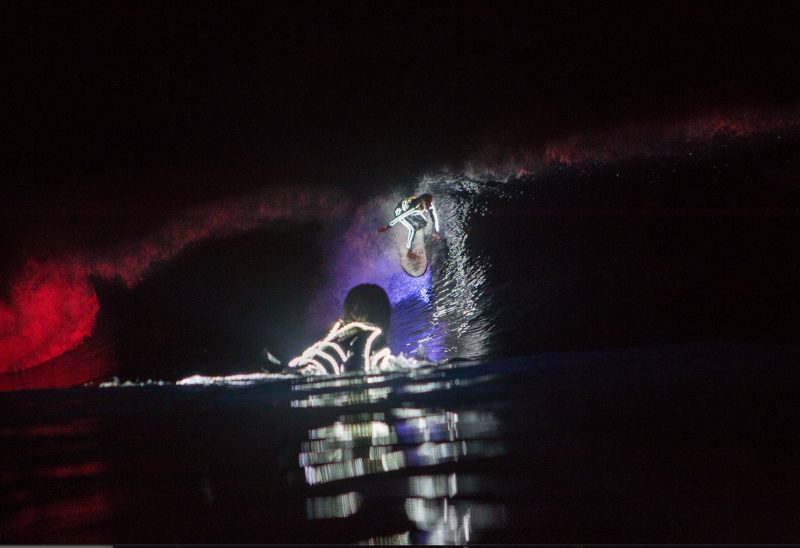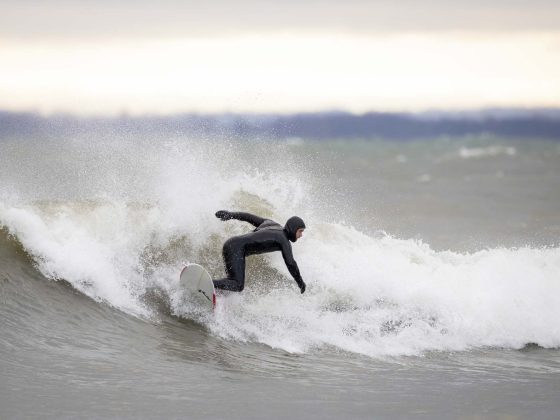The Grateful Dead defied genre, encompassing multiple styles in a seamless whole. Similarly, 2019 short film Fire on the Mountain led viewers on an improvisational journey of snowboarding, skiing, surfing, and music—with a Dead-only soundtrack. Starring snowboarders Jeremy Jones, Danny Davis, Kimmy Fasani, surfer Rob Machado, and skiers Michelle Parker and Chris Benchetler, the film showcased the music of the Dead in dynamic new settings.
The book Fire on the Mountain—A Film Experience by Chris Benchetler and Grateful Dead, released in a limited edition late last year, is a behind-the-scenes look at the making of the film, following athletes and crew around the world. Here we present an excerpt of the surfing section where Rob Machado leads the crew to Indonesia to film night surfing to complement the night snowboard/ski scenes already completed in Mammoth, California and Norway.

The idea was to film [Machado] surfing at night, but lighting up the ocean had its own challenges. “Light doesn’t refract off the open ocean,” Machado says. “It’s not like a mountain, when you have a white canvas of snow. Once the wave breaks, and you have the whitewater, then light will refract off that.”
The answer, it seemed, was to shoot in a more controlled environment than the ocean, like a wave pool. That way they could have lighting equipment overhead and a safer, more predictable swell. But two attempts to film at a wave pool fell through. Machado had already lined up a surf trip to Indonesia, and he half-jokingly invited Benchetler and crew to come along. It was an impractical, way-over-budget option, but it would have to do.
Benchetler pulled money out of his own savings to bring a small film crew all the way to Indonesia for a night shoot of epic proportions. [Shane] Treat spent weeks designing and building a custom wetsuit for Machado equipped with lights, then figured out how to make it safe and submersible. “I had a few hard weeks sketching, crunching numbers, and locating materials for the pieces in my head I imagined I needed to make it work,” Treat says.


The generators, which the crew needed for the lighting package required for a night shoot, got taken at the airport before even leaving the U.S. Regardless of all the research and preparation Benchetler did, as well as fully purging all liquids from the generators, the airline would still not let them fly with the equipment. So they had to improvise and collect diesel generators on the ground in Indonesia. Treat had to basically rewire the power grid on a private island in a remote part of the Indian Ocean.
To film during the day, you have the sun as your guide. But at night? Everything is dynamic, and it’s all in the dark. The athlete is gliding across the water, the ocean is in constant motion, the lighting on the boat is shifting up and down—and you can’t see a thing. The crew had to make all of those elements come together in a cohesive manner. Machado brought in a veteran surf filmer, Timmy Ridenour, who goes by “Timmy Toes.” Ridenour and still photographer Andrew Shield had to float in the open seas, bobbing around like bait with cameras, in inky blackness. On the first night, Treat had the smart idea to ask, “Does anyone know how sharks react to light?”

“I had assumed that filming surfing would be easy. But it was a complete shellacking,” [Tyler] Hamlet says. “We had a third of the size crew, so everyone was doing multiple things.” Some shot from a boat, others from land. Hamlet was part of the ground crew. He had to lug heavy camera and lighting gear a quarter mile up the beach and across a lagoon to get everything staged. Then there were the bugs. In Indonesia, nocturnal insects come out in hordes during a full moon. Even worse, they were Asian tiger mosquitoes, which are known to transmit dangerous diseases. “So, we’re in the jungle with millions of bugs, and every bug is flying straight at us,” Treat says. “They’d come right at the and bite everything they could. We’d have these freak-outs because they’d be crawling up your shorts. We would run straight into the ocean.”
Again, improvisation was key: They wore long pants and shirts and taped the ankles and wrists tight to keep the bugs away.
Since the whole project was filmed at night, Machado was tasked with getting barreled in a wave in complete darkness. “He was essentially surfing blind. it was a big learning curve for him,” says Hamlet.
To film during the day, you have the sun as your guide. But at night? Everything is dynamic, and it’s all in the dark. The athlete is gliding across the water, the ocean is in constant motion, the lighting on the boat is shifting up and down—and you can’t see a thing.
Machado describes it as one of the hardest things he’s ever done. “You’re sitting in the middle of the ocean, looking out at total darkness,” Machado says. “No matter what light you shine, it’s hard to see the wave approaching. Once you catch the wave, it becomes at that point surfing entirely by feel.”
None of it was easy, but it all made perfect sense in a film inspired by the Grateful Dead, a band centered on the idea of improvisation and endless, hypnotic riffs that never sound the same. Their live music was fluid and unique every single night—just like skiing, surfing, and other action sports.

“In skiing and surfing and snowboarding. you never ride the same line twice. You can have your toolbox of skills you’ve acquired over a lifetime, but you’ll never repeat or do the same thing twice,” says Benchetler. “That’s the allure of the Dead, too: You’ll hear the same song, but they’ll never play it the same way twice.”
In 1990, the Grateful Dead released a live double album called Without a Net. It was a compilation of shows from October 1989 until April 1990. On the first disc, keyboardist Brent Mydland sings, “It’s going to be a long, long, crazy, crazy night.” Just like those nights in Indonesia.
Besides, there’s something similar about playing live music and surfing at night. “In music and surfing, there are no rules,” says Machado. “There’s no handbook that says this is how you have to do it.” In both, there is no safety net to fall into, and the show gets better the deeper into the night you go. At that point, the stage becomes an ocean of its own.
Thanks to Fire on the Mountain sponsor Dragon Alliance for providing this excerpt.









